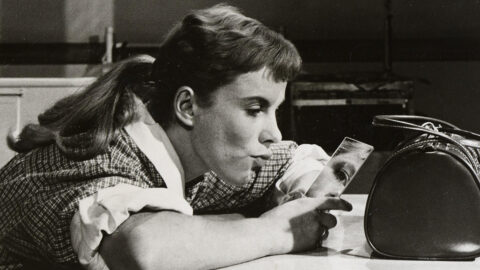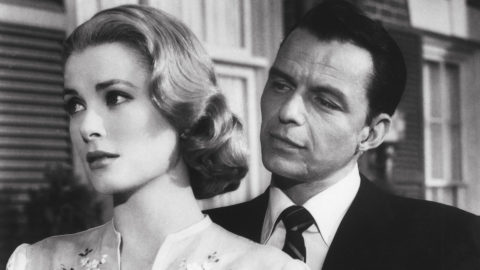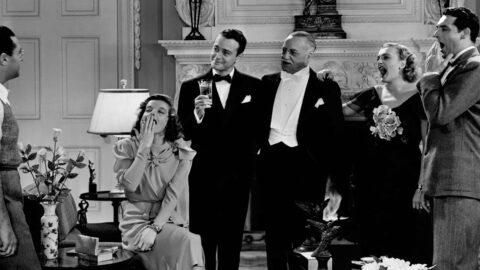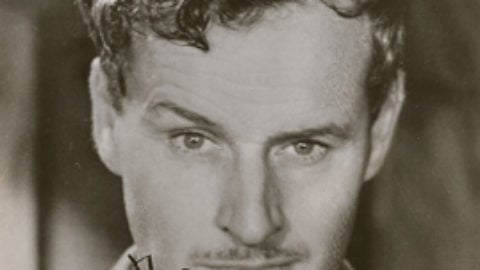TCM Diary: The Chemistry Set
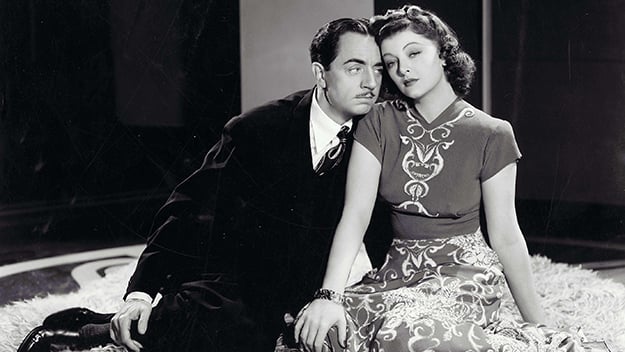
Love Crazy (Jack Conway, 1941)
Sarah: Oh, I’ll know, when my love comes along.
Sky: Mine will come as a surprise to me,
Mine I leave to chance and chemistry
Sarah: Chemistry?
Sky: Yeah, chemistry.—Guys and Dolls
Chemistry is so built into the language of show business that when two actors are brought in to read opposite one another, it’s called a “chemistry read.” Chemistry doesn’t have to be romantic or sexual (buddy comedies rely on it), but romantic comedies live or die on the concept. Spencer Tracy and Katharine Hepburn. Cary Grant and Katharine Hepburn, Cary Grant and Irene Dunne, Cary Grant with everyone. The chemistry between Myrna Loy and William Powell is so intense it can still be felt 80 years later. We are so lucky they did 14 movies together, including six in the Thin Man series. And then there’s Love Crazy, directed by Jack Conway (who also helmed the much-better-known Powell-Loy vehicle Libeled Lady): the movie sizzles with humor, thwarted sex-desire, and so many misunderstandings that at one point Powell falls out of a tree stark naked into the middle of a fancy dinner party. Because that’s how things happen in a screwball universe.
In Love Crazy, Powell and Loy play Steve and Susan Ireland, married for four years, and, judging from the first scene, still in a honeymoon phase, still hot for each other. Every year they celebrate their anniversary with the same ritual of re-creating their wedding day, start to (presumably glorious) finish. This year, though, they decide to do it all in reverse order. Why delay gratification when you’re married?
But the course of an anniversary never runs smoothly, and Susan’s mother—played by the great Florence Bates (whose life story is extraordinary)—shows up at an inopportune moment to drop off a rug for the foyer, and invites herself to stay for dinner. When she sends Steve downstairs on an errand, his trouble begins. Through a series of unavoidable snafus, Steve ends up trapped (literally) in the arms of his old flame Isobel Grayson (Gail Patrick), who has just moved into the building. Isobel is also married, but clearly doesn’t recognize fidelity, in her own life or in the lives of others. One misunderstanding leads to another, and Susan retaliates by propositioning a man whom she thinks is Isobel’s husband. Unfortunately, she has gone to the wrong apartment, and Ward Willoughby (Jack Carson), practicing archery in his undershirt, has no idea why this random woman has shown up demanding that he kiss her. He is only too happy to oblige.
By the end of the night, the “betrayals” are too complex to untangle, and Susan files for divorce. Steve comes up with a plan to act “crazy” in order to delay the proceedings long enough so he can win her back. He ends up in an institution, which is just the beginning of his travails. As Rosalind famously declares in As You Like It: “Love is merely a madness and, I tell you, deserves as well a dark house and a whip as madmen do, and the reason why they are not so punished and cured is that the lunacy is so ordinary that the whippers are in love, too.” She could have been talking about Love Crazy. “The lunacy is ordinary” in this film. Not one stable person resides in that bonkers apartment complex. Behind every door is yet another crackpot. Even the psychiatrists are quacks. Only Myrna Loy seems sane, but even that is in question. Howard Hawks once told Peter Bogdanovich that Bringing Up Baby “had a great fault” in that “there were no normal people in it. Everyone you met was a screwball.” Hawks, it turns out, was wrong. Love Crazy is full of screwballs, too, but it’s anchored by Powell and Loy’s openness to each other—openness to love, hurt, desire, humor—and this openness keeps us hoping they will find a way back to where they belong: in bed.
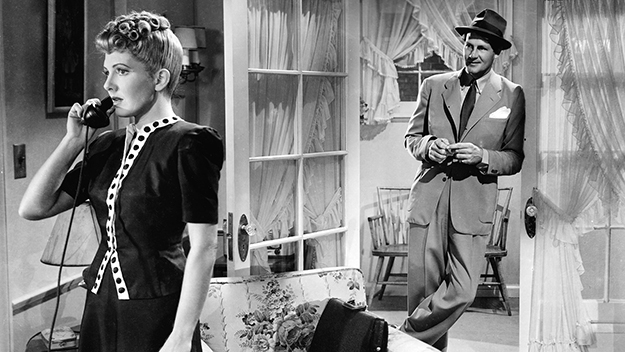
The More The Merrier (George Stevens, 1943)
Another movie couple who belong in bed immediately are Jean Arthur and Joel McCrea in The More the Merrier (1943), their chemistry so scorching it’s incredible the screen doesn’t burst into flames. Directed by George Stevens, the film was developed for Jean Arthur, who had been constantly put on suspension by Columbia Pictures president Harry Cohn for turning down roles. Garson Kanin’s script was initially titled Two’s a Crowd (it would be remade in 1966 as Walk Don’t Run, with Cary Grant). The housing crisis in wartime Washington D.C. (and other cities that were close to the munitions industry and airplane warehouses) was a huge problem, with an unprecedented influx of workers, many of whom were women, filling the jobs previously done by men. The subject appeared in a number of other films around this time. In The More the Merrier, Connie Milligan (Arthur) decides to do her patriotic duty and rent out a room in her apartment. Although she wants to rent to a woman, Benjamin Dingle (Charles Coburn, in an Oscar-winning performance) responds to her ad, and overrides her objections. Behind her back, he then rents half of his room to Joe Carter (McCrea), a laconic guy who shows up carrying a gigantic airplane propeller (we never get an explanation for this). Connie, engaged to be married to a boring bureaucrat with a toupee (Richard Gaines), is suddenly living with two men.
Stevens had a great feel for sparkling romantic connection, giving lots of space for charming people to be even more charming with each other—Swing Time, Talk of the Town, Penny Serenade, Woman of the Year. How this all plays out in The More the Merrier is a high-water mark of comedy and romance, accentuated by the production design of Connie’s labyrinth of an apartment. The confused floor plan, all those doors and rooms, is so essential to the film.
Although repressed Connie and deadpan Joe fall in love from the second they lay eyes on each other, there are many obstacles in their path. The two actors play the subtext of desire with such single-minded devotion that some of their scenes together are almost unbearable to watch. There’s the moment where he gives her a traveling case, and as he shows her all the compartments, she trembles with awareness of his proximity. There are a couple of famous scenes. In one, playing out in a single gliding take, the two of them walk home together, passing canoodling couples on the sidewalk. Connie’s gown reveals her shoulders, and Joe takes advantage of this expanse of skin, touching her neck, her shoulder, even—daringly—her collarbone. McCrea appears to have no less than six hands during this agonizing scene. (McCrea is maybe the only actor who could make “handsiness” not creepy or pushy, but sexy. Joe senses—he knows—she’s aching for it.)
One of the undercurrents of the film is Connie’s loneliness, which both Mr. Dingle and Joe sense. The look on Joe’s face when he hears of the length of her engagement (two years) is eloquent. “That’s a long time…” he says. “A long time with no consummation” is unsaid, but present. Finally, she is unable to fend him off, and—in a breathtaking moment—takes control, grabbing his face to kiss him. It’s one of the sexiest scenes in cinema. Later, they lie in single beds in separate rooms and talk to one another tenderly through the wall separating them, with Stevens creating the illusion that they’re in bed together.
The More the Merrier got into trouble with the Production Code for these scenes, as well as for the use of “Damn” in Mr. Dingle’s oft-repeated favorite quote: “Damn the torpedoes. Full speed ahead!” At first it’s a metaphor for his outlook on life and business, but it shifts into more personal shadings with each repetition. It’s clear that Mr. Dingle takes one look at Connie, one look at Joe, and perceives that they need each other and want each other. He goes to great and sometimes annoying lengths to force these two lonely characters to damn the torpedoes and go full speed ahead, right into bed.
Joel and Jean were never paired up again after The More the Merrier. Why they work so well together is the sense of fraught yearning against obstacles, big obstacles like the war, like her upcoming marriage. But they are drawn together instantly, like a magnetic force. She’s afraid to speak of it. So is he. He may be killed in the war. She’s trapped in an endless engagement to a silly bore. It’s not just sexual desire between Connie and Joe. There’s an enormous tenderness, too, surprising and sweet. Openness is the key, as with Powell and Loy. Chemistry like this doesn’t come along every day. It’s the Holy Grail.
Love Crazy airs on July 29 and The More the Merrier on July 14 on Turner Classic Movies.
Sheila O’Malley is a regular film critic for Rogerebert.com and other outlets including The Criterion Collection. Her blog is The Sheila Variations.



